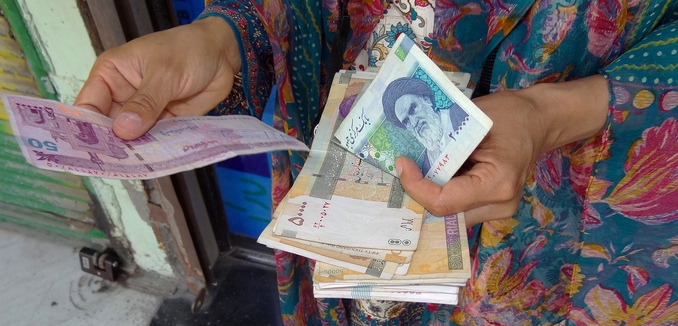Despite complaints from Iranian officials, sanctions relief provided to the Islamic Republic is projected to boost its economy by 3.7 percent in the coming fiscal year and by estimates of more than 4 percent annually over the next five years, according to a study (.pdf) published Wednesday by the Foundation for Defense of Democracies.
In a summary of the study, Mark Dubowitz and Annie Fixler, respectively the executive director of and a policy analyst at the Foundation for Defense of Democracies, described the state of the Iranian economy before it received sanctions relief during the nuclear negotiations and after last year’s nuclear deal:
In 2012 and 2013, Iran’s economy was crashing. It had been hit with an asymmetric shock from sanctions, including those targeting its central bank, oil exports, and access to the SWIFT financial messaging system. The economy shrank by more than six percent in the 2012/13 fiscal year, largely due to the drop in oil exports and revenue because of tightening sanctions, and bottomed out the following year, contracting by another two percent. Accessible foreign exchange reserves were estimated to be down to only $20 billion, limiting imports.
During the 18 months of public negotiations, measures to relax sanctions and grant Iran access to previously restricted funds allowed the country to begin a “modest” economic recovery. Nearly $12 billion in restricted assets were freed while the Obama administration blocked congressional action on any new sanctions. This led to a growth in imports, especially from China, which in turn spurred domestic spending. Iran’s economy and its leadership, including the Islamic Revolutionary Guard Corps, were consequently spared a major balance of payments crisis.
During the 2014-5 fiscal year, Iran’s economy grew by at least 3 percent, and the situation has only improved since the implementation of the nuclear deal this past January.
Now, under the Joint Comprehensive Plan of Action (JCPOA), Iran has received access to an additional $100 billion in previously frozen foreign assets, significantly boosting its accessible foreign exchange reserves. As we described in our previous reporting on this topic, while Iran has access to $50-60 billion in liquid assets, its total funds are closer to $100 billion. Excluding previously allocated funds from this total fails to adequately estimate the effect of releasing previously frozen assets on the economy. Some of these allocated funds are collateral for joint ventures or deposits for imports. Thus, while these funds are unavailable for new investments, the payoff from the previous allocations will positively impact the Iranian economy.
Sanctions have also been lifted from Iran’s oil exports, as well as from major sectors of Iran’s economy. The country has also been granted greater access to the international banking system, allowing it to conduct business globally with more flexibility and lower costs.
Despite these improvements, Iranian Foreign Minister Mohammad Javad Zarif recently claimed that while the United States has lifted sanctions “on paper,” it still needed to remove the “psychological remnants” of sanctions. “On the banks, I believe it is important for everybody to realise that an agreement will be sustainable if everybody feels they are making gains from the agreement,” he added.
Iranian Supreme Leader Ayatollah Ali Khamenei was more blunt in his comments. Khamenei claimed on Twitter that the “US didn’t fulfill key part of commitments; oil money isn’t paid to us, while we’ve done our part, 20% enrichment, Fordow & Arak are stopped.” He even went so far as to threaten to “set fire” to the agreement.
Iran’s top banker Valiollah Seif similarly threatened in April that without more financial concessions, the nuclear deal would “[break] up under its own terms.”
However, Dubowitz and Fixler noted that further improvements in Iran’s economy are up to the country itself. “Assuming that Iran continues to make modest economic reforms to attract investment, this report forecasts its economic growth will stabilize around 4 to 4.5 percent annually or higher over the next five years,” they wrote.
These improvements could result from increasing privatization, cracking down on corruption and money laundering, and stopping terror financing. “These factors increase the risks of investing in the Islamic Republic, regardless of what deal-sweeteners the White House provides,” Dubowitz and Fixler argued. Their conclusion is consistent with a number of other assessments.
The International Monetary Fund warned last month that Iran must cease funding terrorism if it wants to rejoin the global economy. Former U.S. Treasury official and current chief legal officer of the banking giant HSBC, Stuart Levey, similarly wrote that despite the Obama administration assurances that it was safe to engage with Iran, HSBC would not risk doing business with the country as long as it was plagued by the same “financial-crime risks and the underlying conduct” that led to it being sanctioned in 2005.
Even The New York Times, whose editors supported the nuclear deal, observed that Iran “has not kept up with strict new rules to prevent money-laundering and terrorist financing. Experts say Iranian banks are badly run, politicized and lack transparency — warning signs for risk-averse foreign banks. Iran’s warlike behavior in the region — supporting President Bashar al-Assad in Syria, arming Hezbollah and testing missiles — further discourages investment.”
[Photo: Adam Jones / Flickr ]




